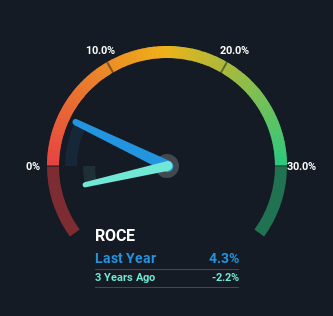- India
- /
- Infrastructure
- /
- NSEI:DREDGECORP
Returns At Dredging Corporation of India (NSE:DREDGECORP) Are On The Way Up

Did you know there are some financial metrics that can provide clues of a potential multi-bagger? One common approach is to try and find a company with returns on capital employed (ROCE) that are increasing, in conjunction with a growing amount of capital employed. Put simply, these types of businesses are compounding machines, meaning they are continually reinvesting their earnings at ever-higher rates of return. With that in mind, we've noticed some promising trends at Dredging Corporation of India (NSE:DREDGECORP) so let's look a bit deeper.
Understanding Return On Capital Employed (ROCE)
For those that aren't sure what ROCE is, it measures the amount of pre-tax profits a company can generate from the capital employed in its business. To calculate this metric for Dredging Corporation of India, this is the formula:
Return on Capital Employed = Earnings Before Interest and Tax (EBIT) ÷ (Total Assets - Current Liabilities)
0.043 = ₹730m ÷ (₹24b - ₹6.7b) (Based on the trailing twelve months to December 2023).
Therefore, Dredging Corporation of India has an ROCE of 4.3%. In absolute terms, that's a low return and it also under-performs the Infrastructure industry average of 11%.
View our latest analysis for Dredging Corporation of India

Historical performance is a great place to start when researching a stock so above you can see the gauge for Dredging Corporation of India's ROCE against it's prior returns. If you'd like to look at how Dredging Corporation of India has performed in the past in other metrics, you can view this free graph of Dredging Corporation of India's past earnings, revenue and cash flow.
The Trend Of ROCE
Dredging Corporation of India has broken into the black (profitability) and we're sure it's a sight for sore eyes. The company now earns 4.3% on its capital, because five years ago it was incurring losses. While returns have increased, the amount of capital employed by Dredging Corporation of India has remained flat over the period. With no noticeable increase in capital employed, it's worth knowing what the company plans on doing going forward in regards to reinvesting and growing the business. Because in the end, a business can only get so efficient.
For the record though, there was a noticeable increase in the company's current liabilities over the period, so we would attribute some of the ROCE growth to that. Essentially the business now has suppliers or short-term creditors funding about 28% of its operations, which isn't ideal. It's worth keeping an eye on this because as the percentage of current liabilities to total assets increases, some aspects of risk also increase.
Our Take On Dredging Corporation of India's ROCE
To sum it up, Dredging Corporation of India is collecting higher returns from the same amount of capital, and that's impressive. And with the stock having performed exceptionally well over the last five years, these patterns are being accounted for by investors. So given the stock has proven it has promising trends, it's worth researching the company further to see if these trends are likely to persist.
Before jumping to any conclusions though, we need to know what value we're getting for the current share price. That's where you can check out our FREE intrinsic value estimation for DREDGECORP that compares the share price and estimated value.
While Dredging Corporation of India isn't earning the highest return, check out this free list of companies that are earning high returns on equity with solid balance sheets.
New: Manage All Your Stock Portfolios in One Place
We've created the ultimate portfolio companion for stock investors, and it's free.
• Connect an unlimited number of Portfolios and see your total in one currency
• Be alerted to new Warning Signs or Risks via email or mobile
• Track the Fair Value of your stocks
Have feedback on this article? Concerned about the content? Get in touch with us directly. Alternatively, email editorial-team (at) simplywallst.com.
This article by Simply Wall St is general in nature. We provide commentary based on historical data and analyst forecasts only using an unbiased methodology and our articles are not intended to be financial advice. It does not constitute a recommendation to buy or sell any stock, and does not take account of your objectives, or your financial situation. We aim to bring you long-term focused analysis driven by fundamental data. Note that our analysis may not factor in the latest price-sensitive company announcements or qualitative material. Simply Wall St has no position in any stocks mentioned.
About NSEI:DREDGECORP
Dredging Corporation of India
Provides dredging services to various ports, the Indian navy, fishing harbors, and other maritime organizations primarily in India.
Imperfect balance sheet very low.

